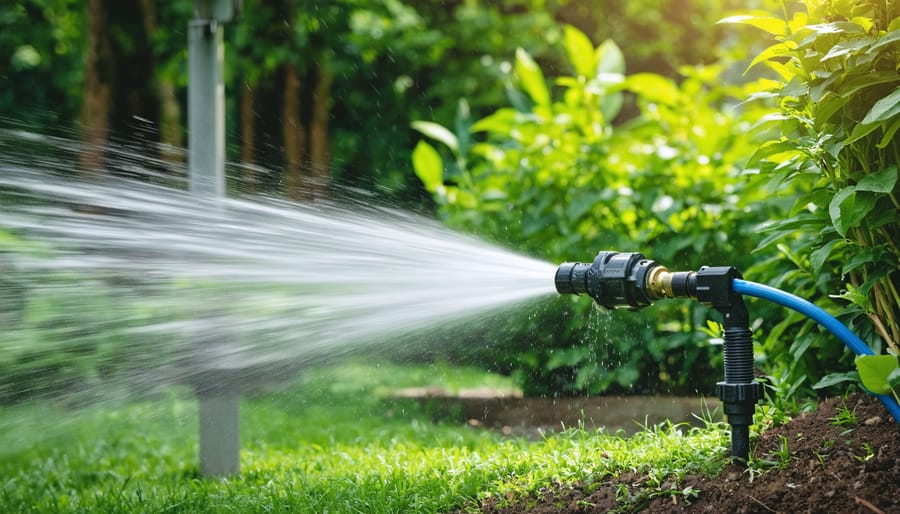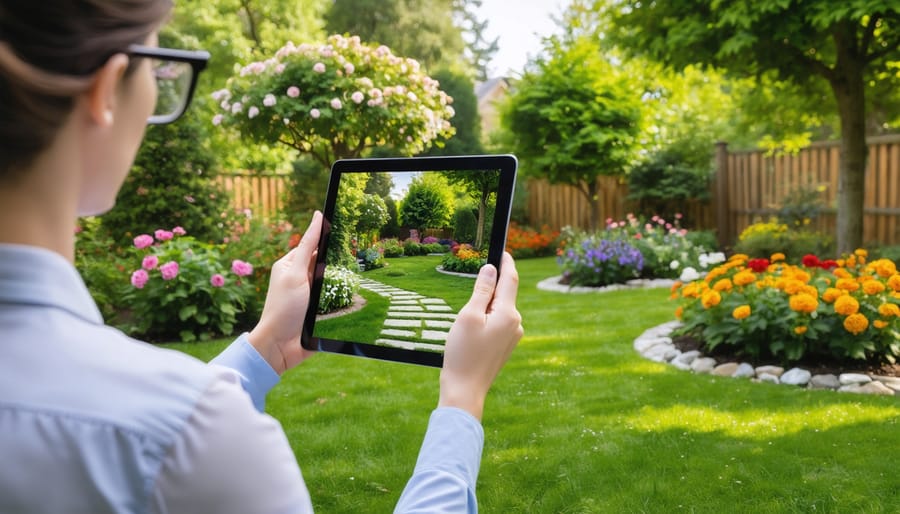Transform your garden’s produce tracking system by combining QR codes with blockchain produce traceability – a revolutionary approach that ensures transparency from seed to harvest. Generate unique QR codes for each planting bed or crop variety, linking directly to an immutable blockchain record that captures planting dates, organic practices, and harvest details. Modern gardeners are embracing this digital solution to build trust with local buyers and maintain detailed growing histories without paperwork. By scanning these weather-resistant QR code labels, anyone can instantly access verified information about your produce’s journey, including cultivation methods, harvest dates, and handling procedures. This seamless integration of traditional gardening with cutting-edge technology creates an unbreakable chain of trust between growers and consumers, while simplifying record-keeping for home gardeners and small-scale producers alike.
Why Garden Produce Tracking Matters
Food Safety and Quality Assurance
QR code blockchain technology revolutionizes food safety by creating an unalterable record of your produce’s journey from seed to harvest. Each scan provides instant access to vital information about growing conditions, fertilizer use, and harvest dates, helping maintain the highest quality standards. When you scan a produce item’s QR code, you can view its complete history, including temperature logs during storage and transportation, ensuring optimal freshness.
For home gardeners and small-scale producers, this means better control over produce quality. You can track which growing methods yield the best results and identify any issues before they affect your entire crop. The system also helps maintain compliance with food safety regulations by automatically documenting important safety checkpoints, from proper handling procedures to storage conditions.
This transparent tracking builds trust with consumers who can verify the authenticity and safety of their produce with a simple smartphone scan.
Building Trust with Local Buyers
For gardeners selling at farmers markets, QR codes linked to blockchain technology offer a powerful way to build trust with local buyers. When customers scan your produce’s QR code, they can instantly view your growing practices, harvest dates, and even photos of your garden. This transparency helps create meaningful connections with shoppers who care about where their food comes from.
Many market gardeners report that customers appreciate being able to verify organic growing methods and learn about specific varieties. By sharing details about companion planting, natural pest control, and sustainable watering practices, you demonstrate your commitment to quality produce. The immutable nature of blockchain ensures that this information can’t be altered, giving customers confidence in the authenticity of your claims.
This technology also allows you to share your gardening story and build a loyal customer base who values your dedication to sustainable local food production.

How QR Code Blockchain Works in Your Garden
Setting Up Your First QR Code System
Getting started with a QR code tracking system for your garden produce is simpler than you might think. Let’s break it down into manageable steps that you can implement over a weekend.
First, choose a blockchain platform that supports QR code integration. For home gardeners, platforms like Hyperledger Fabric or Ethereum are popular choices, offering user-friendly interfaces and strong security features. Think of it as setting up a digital garden journal that can’t be altered.
Next, create your first QR code using a blockchain-enabled QR generator. Start with just one crop variety – perhaps your prized tomatoes. Input basic information like planting date, variety name, and growing location. The platform will generate a unique QR code that contains this information securely on the blockchain.
Print your QR codes on weather-resistant labels or cards. I’ve found that laminated cardstock works well in garden conditions. Place these near your plants or attach them to your garden markers. Make sure they’re positioned where they won’t be damaged by watering or garden tools.
Download a blockchain-compatible QR scanner app on your smartphone. Test your system by scanning the code – you should see all the information you entered, along with a timestamp and verification that it’s authentic.
Start small and expand gradually. As you become comfortable with the system, you can add more detailed information like fertilizing schedules, harvest dates, and even photos of your plants’ progress.
Recording and Updating Produce Data
Keeping accurate records throughout the growing season is essential for successful QR code blockchain implementation in your garden. Start by establishing a consistent recording schedule – weekly updates work well for most crops. During each session, document key information like plant growth stages, watering patterns, and any treatments applied.
Using smart garden data tracking tools alongside your QR system makes the process much easier. Simply scan each plant’s QR code and input the latest data directly into your blockchain platform. Remember to photograph your plants regularly – these visual records are invaluable for tracking progress and identifying potential issues early.
Create a simple checklist for your recording sessions:
– Plant height and spread
– Flowering or fruiting status
– Recent weather conditions
– Fertilizer applications
– Pest observations
– Harvest dates and yields
Don’t worry about being perfect – consistency matters more than perfection. Set reminders on your phone for recording days, and keep your mobile device charged and ready for scanning. If you notice anything unusual between scheduled updates, make a quick note and add it during your next session.
By maintaining regular records, you’ll build a valuable database that helps improve your gardening practices year after year. Plus, having this detailed history makes it easier to share growing tips with fellow gardeners and verify your produce’s journey from seed to harvest.
Real Benefits for Home Gardeners
Personal Garden Management
QR codes paired with blockchain technology bring a new level of precision to personal garden tracking. By implementing these garden management systems, you can create an immutable record of your planting schedule, crop rotations, and harvest yields.
Each garden bed or growing area gets its unique QR code, which you can scan with your smartphone to log activities and access historical data. When you plant new crops, simply scan the code and record what you’ve planted, when you planted it, and any amendments you’ve added to the soil. This creates a reliable digital journal that helps you make informed decisions about future plantings.
The blockchain aspect ensures your gardening records remain secure and unalterable, perfect for tracking organic growing practices or sharing data with other gardeners in your community. You can easily monitor which crops performed well in specific locations and plan your rotations accordingly. The system also helps you maintain optimal spacing between companion plants and track successful combinations for future seasons.
Selling at Local Markets
QR code blockchain technology is revolutionizing how local market vendors connect with customers and boost their sales. By implementing a simple tracking system, gardeners can showcase their produce’s complete journey from seed to market stall, building trust and attracting conscientious buyers.
When customers scan your QR code at the market, they can instantly access detailed information about your growing methods, harvest dates, and even view photos of your garden. This transparency has shown to increase sales by up to 25% in pilot programs, as buyers feel more confident about their purchases and appreciate knowing the story behind their food.
The system also helps manage inventory more effectively. You can track which varieties sell best at different markets and times, helping you plan future growing seasons. Many market gardeners report that customers are willing to pay premium prices for produce with verified origins and growing practices.
For market organizers, blockchain tracking creates a more organized and efficient marketplace. It helps verify vendor credentials, manage stall assignments, and ensure produce meets quality standards, making the entire market experience better for everyone involved.

Getting Started Today
Essential Tools and Resources
To get started with QR code blockchain integration for your garden produce, you’ll need several essential tools and resources. First, a reliable QR code generator is crucial – popular options include QR Code Generator Pro or BeaconsInSpace, which offer agricultural-specific templates. For blockchain implementation, user-friendly platforms like IBM Food Trust or TE-FOOD provide excellent starting points for small-scale gardeners.
You’ll also need a smartphone or tablet with a good camera for QR code scanning and a stable internet connection. Consider investing in weather-resistant QR code labels or stickers that can withstand outdoor conditions. These should be specifically designed for garden use, with UV protection and water resistance.
For data management, you’ll want a simple spreadsheet program to track your produce information. Free options like Google Sheets work well for most gardeners. Additionally, consider downloading a blockchain wallet app to manage your digital assets and tracking information securely.
Don’t forget basic gardening tools for attaching labels, such as garden twine, plant stakes, and waterproof markers. These everyday items become essential components of your high-tech tracking system.

First Week Implementation Plan
Let’s break down your first week of implementing QR code blockchain tracking for your garden produce!
Day 1: Set up your digital wallet and choose a blockchain platform that suits your gardening needs. Popular options like Ethereum or Cardano work well for beginners. Install the necessary software and familiarize yourself with the basics.
Day 2: Create your first QR codes for different produce categories. Start small with maybe three or four of your main crops. Design simple labels that include basic information like planting date and variety.
Day 3: Test your system with a small batch of produce. Scan the codes, ensure they’re working properly, and practice uploading data to the blockchain. This is a great day to work out any technical hiccups.
Day 4-5: Begin implementing the system with your current harvest. Label each batch of produce with its unique QR code and record key information like harvest date and growing conditions.
Day 6: Review your first few days of data and make any necessary adjustments to your tracking system. Are the QR codes scanning easily? Is all the important information being captured?
Day 7: Share your new system with fellow gardeners and gather feedback. Consider joining online communities where you can discuss best practices and troubleshoot together.
By implementing QR code blockchain technology in your garden tracking system, you’re not just keeping records – you’re creating a trusted, transparent way to share your growing journey. This innovative approach helps you maintain detailed histories of your plants, from seed to harvest, while building confidence with fellow gardeners and potential buyers of your produce. The combination of easy-to-scan QR codes and secure blockchain records makes it simple to access and share information about your growing practices, soil amendments, and harvest dates. Whether you’re managing a small kitchen garden or a larger community plot, now is the perfect time to embrace this user-friendly technology. Start small by tracking a few of your favorite crops, and gradually expand as you become more comfortable with the system. Your future self will thank you for creating such a reliable and accessible record of your garden’s story.



